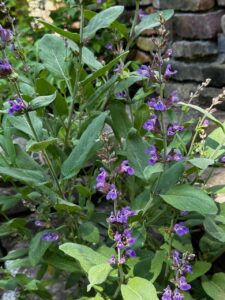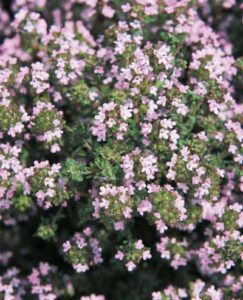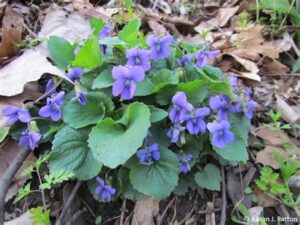Herbs - Plants with Form and Function
March 21, 2024 – Lynda DeWitt

Sage, Salvia officinalis, is a drought-tolerant perennial shrub. Along with the aromatic leaves, the purple-blue flowers are edible. The flowers attract bees and butterflies and will bloom throughout the summer if removed when brown.
One of the best ways to make gardening fun is to grow useful plants. Enter herbs. Making mac & cheese? Add a teaspoon or two of needle-like rosemary leaves. Put a handful of parsley and/or a bay leaf or two in soups and sauces. Add a tablespoon of thyme to your bread dough. Pinch mint leaves for your tea. Lemon balm for your water pitcher. Dill for your broth. Basil for your pesto.
Growing and consuming herbs makes the garden a part of your life and adds value and function to your outdoor space.
Full Sun Not Necessary
Yes, most herbs do best in 6-8 hours of sunlight, but many do fine with half that amount, including thyme, parsley, cilantro, mint, chives, and tarragon. I have a bed that receives only morning sun, where a perennial sage shrub and rambling nasturtiums (annuals easily grown by seeds) have flourished for years.
The flowers of both plants are edible. And unlike most herbs, the leaves of these plants don’t become bitter once flowering begins. I put nasturtium leaves and flowers in salads all summer long, but sage’s strong flavor requires cooking, so best to sauté sage leaves before adding them to roasted veggies or sauces.
If you don’t have enough sun in any of your beds, you can always put an herb or three in containers placed where you do have sun. Mint, of any kind, should go into a container regardless, as it spreads aggressively.

The tiny flowers and leaves of thyme, Thymus vulgaris, add color and flavor to salads and sauces. Leaves of this pollinator plant can typically be harvested throughout the year in our area.
No-to-Low Maintenance
Once you get some herbs in the ground, walk away. They’ll need sunlight, of course, and watering once or twice a week especially if it hasn’t rained that week — or rained very little. But very little else. It’s best to let herbs dry out between waterings. And avoid overwatering. I left containers of basil outside during a week of heavy rain last summer, and the plants nearly died in the saturated soil. Herbs are not heavy feeders, so they rarely need fertilizer.
But how do you get them in the ground in the first place. Three ways: Buy young plants, buy seeds, or propagate from a cutting.
“Propagating lavender, rosemary, mint, basil, and other herbs is so easy,” says Julianna Finelli, Sust’s social media/admin Queen Bee. “It’s faster than seeds and cheaper than buying plants. Don’t be shy about asking friends for a few cuttings. Most herbs benefit from a spring trim anyway.”
Other herbs, such as dill, calendula, chamomile, chives, oregano, and lemon balm, reseed themselves or spread by runners. Let them go! They’ll fill in empty spaces and their flowers will attract beneficial insects as well as pollinators.

The common blue violet (Viola genus) is native to central and eastern North America and related to pansies and Johnny-jump-ups. These edible plants also thrive in shade and can provide a deer-resistant groundcover.
About those Violets …
Not sure how or why our native violet became a plant folks love to hate. Maybe because it’s so common. But violets are herbs, and their leaves and flowers are completely edible. The plants also are favored by the caterpillars of the great spangled fritillary. So, if you have these lovely blue flowers, consider yourself lucky!


